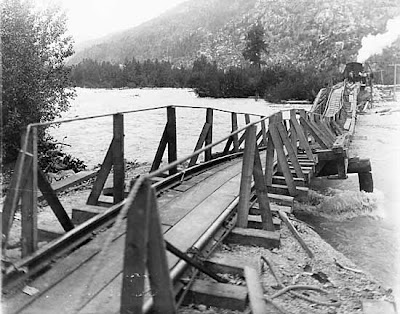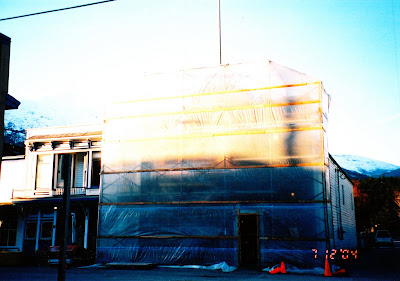
This major flood happened in Skagway in September 1919. This is when the train tracks crossed the Skagway River and ran on the west side of the river and then crossed back to the east side up the way.
“Passenger Trains Between Skagway and Whitehorse Stopped by Flood
Last Friday rain started to fall in torrents in the mountain surrounding Skagway and by the following morning the Skagway river was a raging flood, filled with trees and driftwood, that carried all before it. Four bents were washed out of the railroad bridge near the car shops and eleven bents out of the railroad bridge at four mile post. The weather reached the decking of the first bridge and the driftwood pilling up against it threatened at one time to cause the whole structure to go out, but a flat car with a derrick aboard was put into operation and the trees and logs hoisted over the bridge and dropped into the stream below. The government bridge across the Skagway river at Twenty –Second street was damaged to the extent of having the center span carried away.
At the height of the flood there was a White Pass train stranded between the first and second bridges, but since then the first bridge has been repaired sufficiently to get the train into the yards shops.
After the rain started to fall it continued to pour down almost without cessation until yesterday afternoon, when it commeneed to let up, and the weather was reported to be clearing and river falling.
Section men from Carcross, Pennington, Bennett, Log Cabin, Summit and Glacier were rushed over to Skagway to assist in the work of controlling the flood and are still there.
Yesterday afternoon a telephone message was received here from General Manager II. Wheeler at Skagway, saying that the Skagway river was threatening the track near Boulder and asking that a work train be made up here and rushed over with a load of sacked gravel to use in checking water’s inroads. The train, consist of an engine and three flat cars left here at 7 o’clock this morning to load 500 sacks of gravel at the 98 mile post.
A train was run from Whitehorse Tuesday and the passengers and mail transferred at the washout. They connected with the Princess Alice, which sailed from Skagway Wednesday night. There have been no train since then and it now seems probable there will not be until Saturday or Sunday.
There is a lot of perishable and other freight for the interior now in Skagway which cannot be moved until regular train service is resumed, which will likely be first of next week.
Whitehorse Weekly Star, Friday, September 19, 1919









